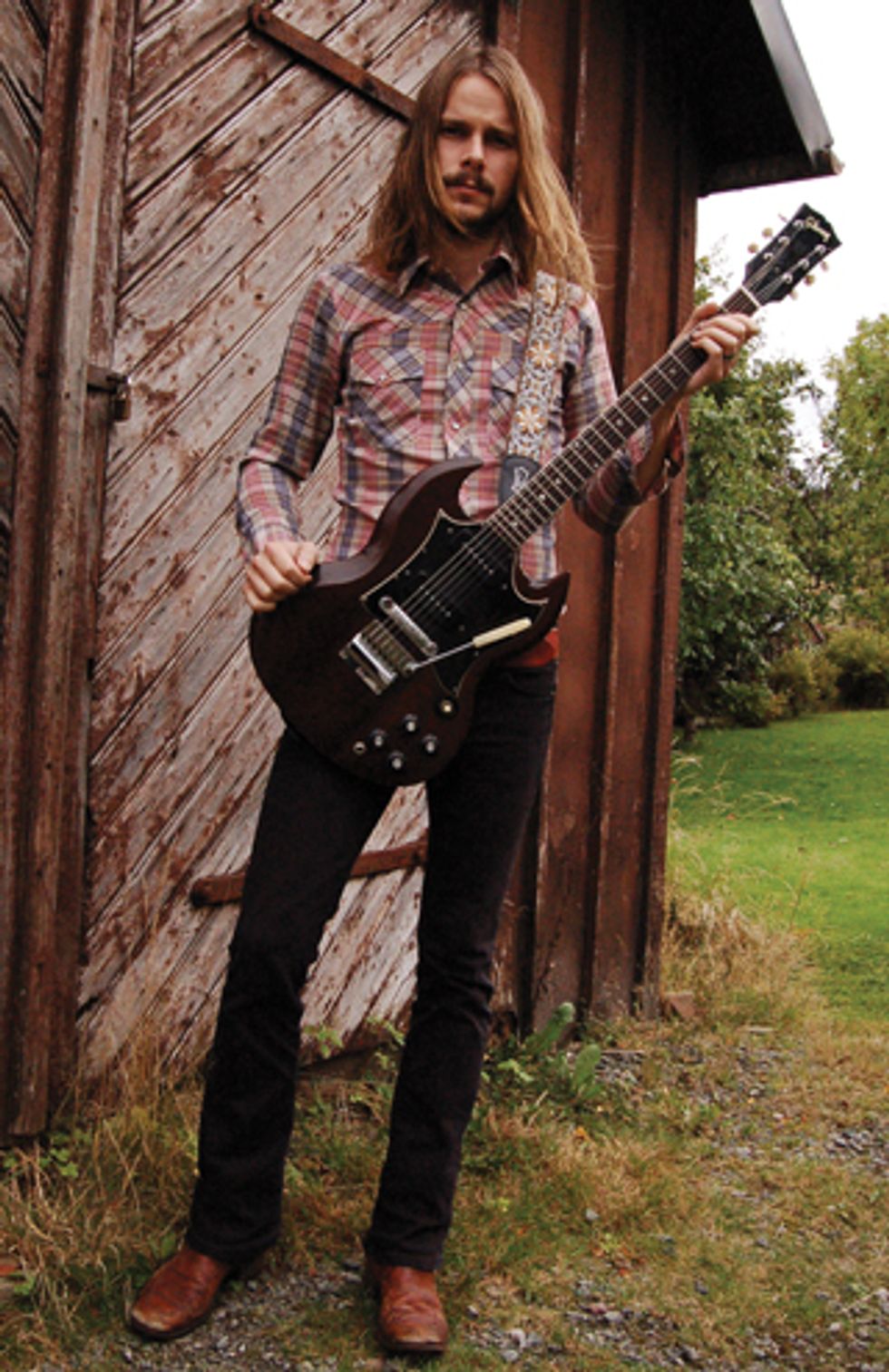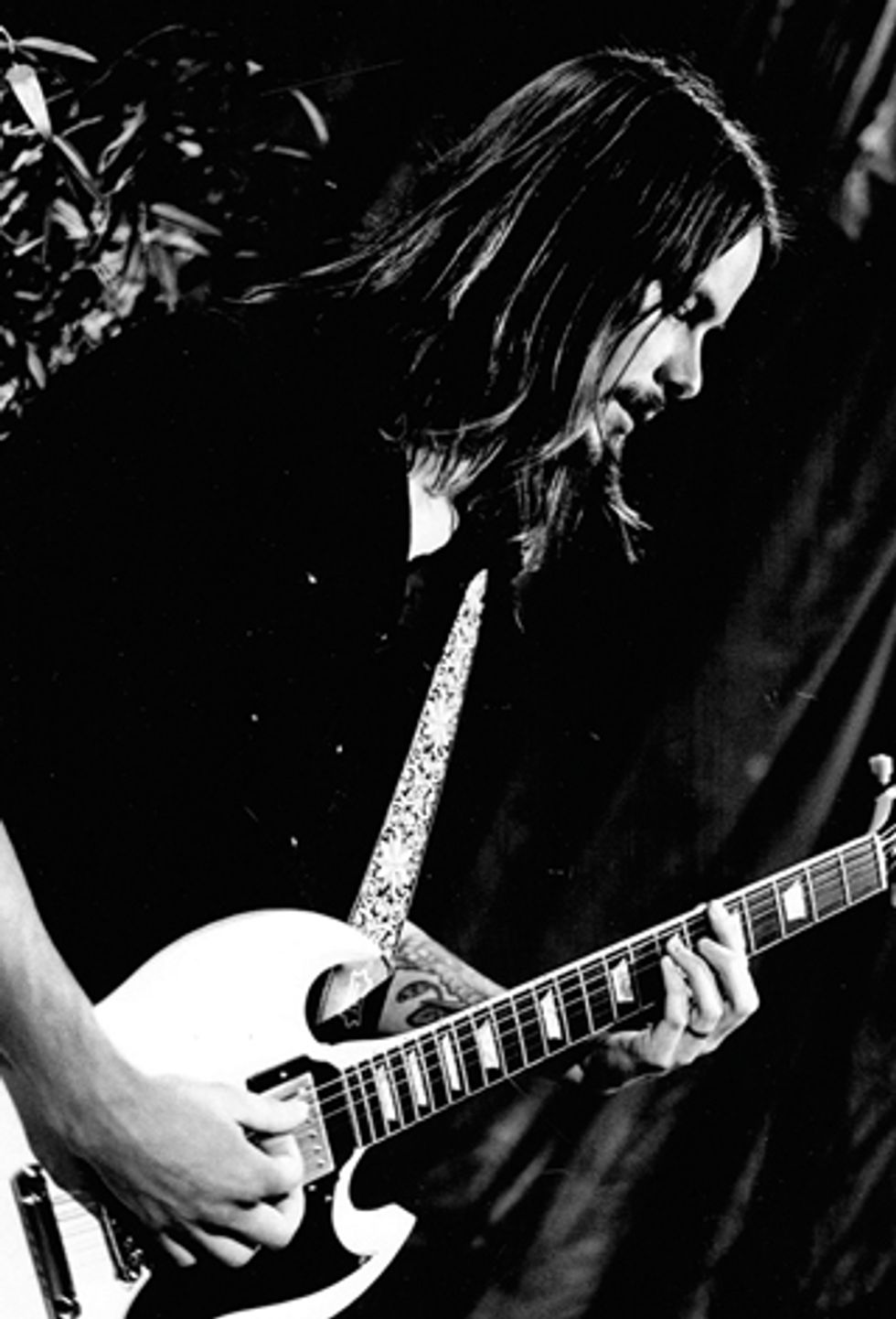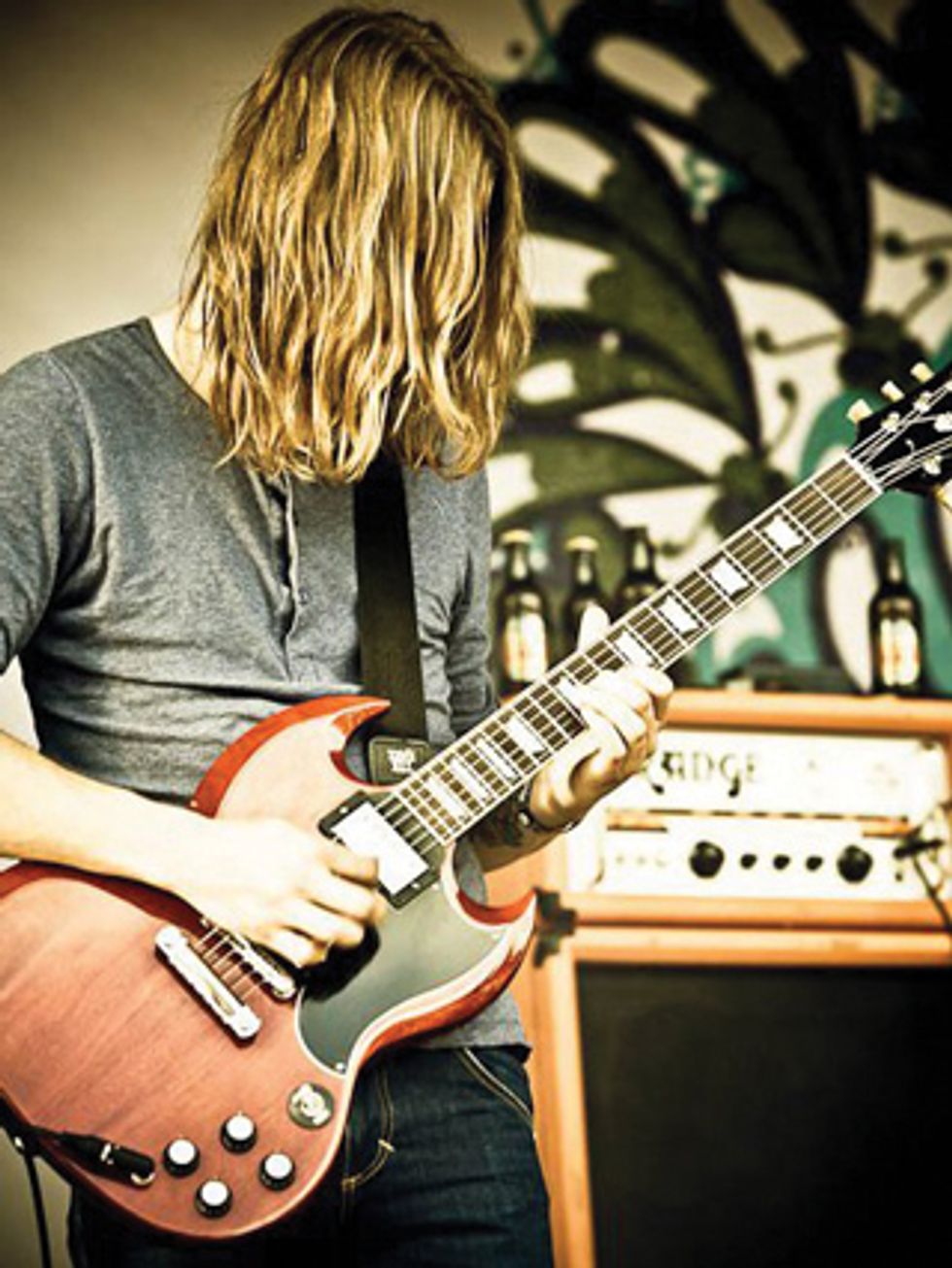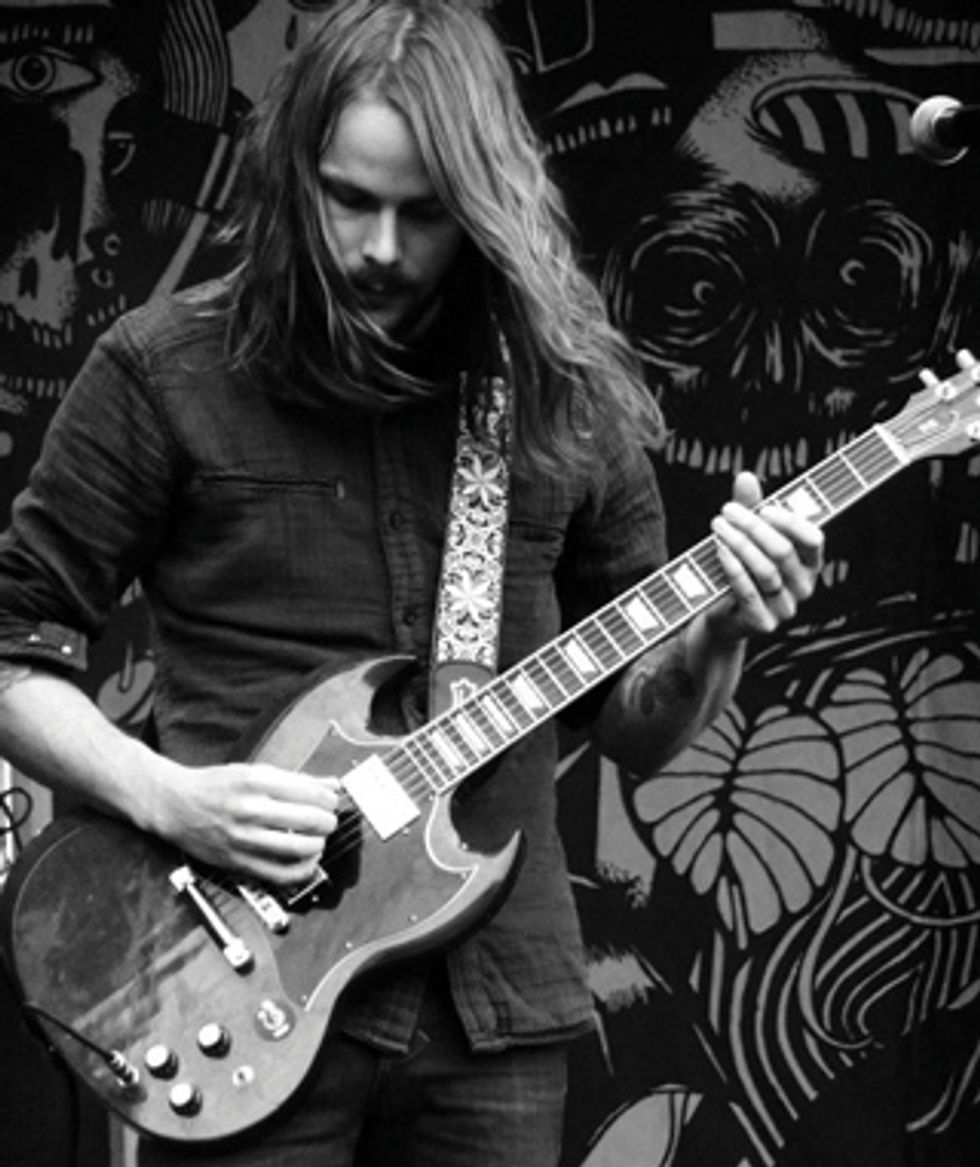Graveyard guitarist Jonatan Ramm discusses how his ’68 SG, Peter Green, and being willing to experiment with slide and saxophone illuminated his band’s classic-metal adventures on Lights Out.

Jonatan Ramm in his backyard in Gothenburg, Sweden, with his favorite SG—a ‘68 Special loaded with the guitar’s original P-90 pickups.
Graveyard would fit into the music scene of, say, 1969 far better than they do 2012’s. Hailing from Gothenburg, Sweden, the classic-metal quartet seamlessly melds late-’60s and early-’70s influences to create a sound so raw, loose, and grooving that, upon first listen, newcomers might wonder if they’ve just discovered some cult band’s long-lost tapes from decades back. Singer Joakim Nilsson’s howling, gritty vocals dance around from a cathartic “White Room”-like Jack Bruce to a hair-raising “Whole Lotta Love”-ish Robert Plant, while bassist Rikard Edlund and drummer Axel Sjöberg’s plodding rhythms anchor guitarist Jonatan Ramm’s heavy blues riffs to create a manic, drug-hazy mélange that’s equal parts Sabbath, Zeppelin, and Cream, with hints of old Fleetwood Mac and the Doors.
“We play music we would want to hear if we were in the crowd watching us,” says Ramm. “It’s not so much a throwback, trying to sound vintage or old school. I just think we’re hitting at the right time when people are tired of overproduced, computerized, formula-based music.”
After their 2007 self-titled debut went practically unnoticed, Graveyard smoothed out their coarse sound and made a thunderous entry with 2011’s critically acclaimed Hisingen Blues—which landed on three Billboard charts and multiple year-end-best-of lists, and earned a Swedish Grammy for Best Hard Rock Album. But even when their star began to rise, Graveyard never lost that garage-band mentality. Ramm and Co. thought about going elsewhere to jam, write, and record this year’s Lights Out, but ultimately they opted to stay in Gothenburg’s snowy gloom.
“A change of scenery is always an option for writing and recording, but we’re inspired and influenced most by everyday life around us,” says Ramm. “The long, gray winters affect our songs and moods. It might not be the perfect place to be all the time, but it’s proven to be an ideal place to write our style of music and songs. We write best when it’s not sunny [laughs].”
From their debut to their sophomore effort, Graveyard evolved to add textural layers like background vocals and atmospherics, and with Lights Out, they’ve found their psychedelic-doom-rock groove.
“We just continue to jam and add new things as they fit and musically make sense—this time we worked in a heavily Stooges-influenced part complete with a saxophonist,” says Ramm. “I even learned to play slide guitar for the first time—even though what I did on the album I wouldn’t call slide guitar [laughs] … I just used a slide for the first time.”
We recently caught up with Ramm to discuses his treasured ’68 Gibson SG Special, why he tries to avoid using pedals, and how Sabbath’s “Wizard” changed his life.
What are your earliest guitar memories?
During my mid-teens and after a few years
of playing by myself, I started a band in
my small hometown for fun. But when I
heard Black Sabbath’s “Wizard” off Black
Sabbath for the first time—[laughs] things
changed after that. That’s the moment that
I knew I was going to play guitar for the
rest of my life.
The guitar riff and its interplay with Ozzy’s harmonica parts made it gel. Tony [Iommi]’s main riff is so heavy, but it’s so catchy, so bluesy. It’s an experience to hear that song—even to this day I get chills to hear how they mixed dark, dirty blues with the beginnings of heavy metal music.
Who are some of the other guitarists
you admire?
I think the tops for me would be Peter Green
and Danny Kirwan of the early Fleetwood
Mac days. If I could pick one player’s tone to
have as my own, I think it’d have to be Peter
Green’s off of “Albatross” or anything from
Peter Green’s Fleetwood Mac. His sound was
iconic, but what really does it for me is his
phrasing—the feeling he conveyed through
his instrument, and how the guitar became
an extension of his mind and soul. But lately
I’ve been really gravitating towards Danny
Kirwan’s incredible vibrato work on Then
Play On, because it is so vivid and comes to
life right off the record.
How has your appreciation for Kirwan’s
vibrato come through in Graveyard?
Wanting to improve my vibrato influenced
me to switch to Ernie Ball Skinny Top
Heavy Bottom .010–.052 strings, because
we tune down to D and I’m able to use my
vibrato more effectively and complementary
with the thinner strings. But I still
prefer the thicker-gauge strings on bottom
for bigger, more powerful chords.
Which elements of the band’s sound
would you say are most indicative of the
Peter Green and Fleetwood Mac influence?
The melancholic vibe in their music
speaks to me a lot. I don’t know if I’ve ever
enjoyed listening to happy music at all,
and if you listen to Graveyard, we don’t
have the sunniest of songs either. The song
“Dragonfly” is a great example of how
they were working with harmonies, vocal
progressions, and that’s definitely something
I try to achieve with Joakim—you
can hear it in certain musical arrangements
and overall compositions like in “20/20
(Tunnel Vision)” off Lights Out.

Prior to Graveyard’s recent video shoot for “Goliath,” Ramm asked his manager to help him acquire a white SG because, he says with a laugh, “White guitars have always had this elegance and I figured it’d be the perfect video guitar.”
You weren’t with the band for the 2007
debut. How did you land this gig?
[Graveyard’s bassist] Rikard was at a show
I was playing and liked how I sounded, so
he asked me to stop down to the studio
to jam. While the band was working on
their debut, Graveyard, they asked me to
add some solos to their songs that were
already worked out. I guess they liked what
they heard, because they not only kept my
guitar parts on the album, but they asked
me to join the band. They only started
Graveyard I think about three months
before they asked me to jam and record
some parts. But I am thankful every day
that they gave me a shot.
Since Joakim also plays guitar, how do
you make sure your parts stand out but
also complement his playing?
One thing I try do whenever possible is
pick the individual strings in an arpeggiated
manner, so you can hear each
string rather than bang out the chords.
It provides a broader feel and shimmer
instead of the cluttered sound of
strumming or rocking through those
same chords. I’m more of a rhythmic
guitarist, even in my soloing—I just
prefer to stay locked in to what Rikard
and Axel are doing to keep the song and
flow intact. Joakim is actually a pretty
gifted guitar player, and he can typically
play the faster stuff a lot better than I
can right off the bat. Our two different
styles and tendencies blend real well and
help us sound unique without stepping
all over each other.
Which pieces of gear are central to
your sound?
I use an old Custom 100 Hiwatt amplifier
with two different Gibson SGs—one
has the standard humbuckers, but my
brown ’68 SG has its original P-90s that
seem to cut through when I play with
the band a bit more. I don’t really use
overdrive pedals too much in my setup. I
generally get most of my distortion from
the amp, but I do have two MXR pedals—
a GT-OD and a Micro Amp—and a
Boss TU-2 tuner. I use the GT-OD for a
bit more bite and growl, because getting
the Hiwatt to naturally overdrive would
blow some windows out at the clubs we
play [laughs]. The Micro Amp works like a
volume boost for soloing and pushing the
front end of the amp harder.
What do you like so much about
Gibson SGs?
I really dig the sound of my ’68 with P-90s
because of their girth and growl, but they
still maintain a distinctive clean tone when
I need that. I couldn’t believe I found a ’68
with P-90s at a decent price point—the neck
was cracked, so that’s why I could afford it.
It has become my favorite guitar and the one
I use the most. I really like a rounder, fuller
neck like a ’58 Les Paul, and my ’68 SG is
really close so it’s ideal. I had a few ’61 SG
Reissues and the necks were broader and flatter—
those were a struggle for me to use.
How is your Hiwatt typically dialed-in?
I generally use the high or low inputs of the
bright channel and dial the volume and master
volume all the way up. I use my SG’s volume
knobs for cleaner or softer tones. For the
EQ, I just have the bass, middle, and treble set
at about 2 o’clock and presence at noon—for
me and what I do in Graveyard, it gives me a
very clear, cutting, classic rock ’n’ roll tone.

Ramm playing his No. 2 Gibson SG, a 2010 Standard model with stock humbuckers.
You guys branched out a bit, stylistically,
on Lights Out. What was the goal this
time around?
Just to make good songs and broaden our
material even more than on Hisingen Blues.
We’ve never really had any plans to go in a
certain direction or create something that
sounds a certain way. We just try to make
songs that we like as if we were the audience.
One thing that I think is big for what we do is that we jam a lot—more than any band I’ve been in before. I know a lot of bands and musicians practice and rehearse for tours and right before studio sessions, but we play and rehearse all the time just to hang out and pass the time. When one of us brings an idea for a song to the practice space, we try and jam on it for a while and take it through the collective grinder. We might end up with something completely different than where the idea started, but that’s why we embrace jamming.
If we just came together to rehearse or to bring ideas to flesh out, we wouldn’t get as diverse or eclectic with our songs—and that’s what I think you’re continuing to hear in Lights Out.
Graveyard albums have a very organic,
vintage-’70s feel—down to the sorts of
crackles we associate with vinyl. How
do you achieve that in a world dominated
by digital recording equipment?
Don [Ahlsterberg, producer] uses all-analog
equipment and records onto
tape—it’s been that way since we
recorded the first Graveyard album in
2007. He actually hates all that digital
stuff, but that’s why we choose to continue
to work with him to this day—he
knows what we like and we appreciate
and understand his approach to recording.
Plus, he pushes us to record live as a
full band as much as we can. Our goal is
to capture and harness the raw emotion
and feeling that’s produced when we’re
all playing music together as a cohesive
unit. We’re not looking to be perfect—
it’s not supposed to be, at least in our
eyes. I mean, that’s what makes music
so beautiful, natural, and special is the
human element. If I completely screw
something up, we’ll redo it, but we don’t
worry about every snare hit or upstroke
on the guitar being precise. That type
of programmable logic makes music feel
forced and stale.
For solos, I generally take my time and redo those after our live take. I like to plan things out and really do a service to the song and make sure it fits and it’s not just me noodling all over the song with no rhyme or reason. However, there were a few solo parts on Lights Out that were live takes, like sections of “Seven Seven” and “Endless Night.”
In the last minute of “An Industry of
Murder,” you play two small solos—
the first is very melodic and locked-in,
and the second is a bit crazier—what
were you going for there?”
In the first part, I was trying for more
of an intro or build-up, with a complementary
rhythm riffing that coincided
with what Rikard and Axel were doing
that led into the actual solo, or the second
part you identified. For that part,
I’m playing the song out alongside the
siren-sounding theremin. I figured I’d try
something new and different, so I used
Don’s wah pedal. I’m no Hendrix with
the wah, but I wanted to add another
tone that meshed with the theremin’s
funkiness. It’s the only spot I use a wah
on the record and it works. With the
wah, I think moderation is key, otherwise
it sounds gimmicky.

“We play music we would want to hear if we were in the crowd watching us,” Ramm says.
You get some pretty amazing feedback
leading into the solo in “Seven Seven.”
I was pushing the headstock into my
amp head while crawling around on my
knees and playing to get enough feedback
because the Hiwatt has a lot of
headroom. I sometimes turn on either
one of MXR pedals to cheat a bit and
boost the volume and push the amp
even harder, but I prefer to just do it
with my guitar and amp only. Feedback
is spontaneous. It’s different every time
you go for it, but what I always try to
do is start small and controlled, because
you’re able to keep things musical and
in check. Incrementally increasing
volume and squeal is easier than trying to
put the lid back on a monster once you’ve
awoken it [laughs].
“The Suits, the Law, & the Uniforms”
sounds like a CCR cover done by
Sabbath. How did that come about?
I just start every song looking to take a
chance. For that one, we all dialed in how the
song was going to be structured and the pace
of Joakim’s vocals, I wanted to go for a very
aggressive, bluesy-meets-punk tone. I recorded
all the main parts with my SG in the neck
position and used one of the MXR pedals to
get that extra oomph and creaminess.
Near the end, it sounds like there are some
horns making a ruckus in the background—
like something you’d hear from the Stooges.
[Laughs.] That’s totally what we were
going for, but no one can do it like the
Stooges. Their song “Fun House” was
our inspiration. We had already recorded
the song and just thought during playback
that all the song was missing was a
saxophone—something you don’t hear
in most rock bands. We had a local saxophonist
come down, because we wanted
to make it a bit more offbeat and different
from our typical Graveyard stuff—and
we’ve all been really getting into the
Stooges, so we went for it.
What prompted you to play slide on
“Endless Nights”?
It was one of the last songs we worked on
and I was worried that my playing was
becoming stale or redundant, so I figured
if I played slide—even if not very
good—it would be different. It worked
out as a good experiment. It was out of
my comfort zone and really pushed me
to focus. I think you have to do that to
grow as a guitarist instead of just learning
scales or playing faster notes. I don’t even
know exactly what open tuning I’m in—
somewhere between C and G—because
I had to tweak each string to get in a key
that Joakim could sing over. I have some
work ahead of me before we decide to play
that song live. I’m just glad the guys were
patient with me.
Jonatan Ramm's Gear
Guitars
1968 Gibson SG Special, 2010
Gibson SG Standard
Amps
Hiwatt Custom 100, Orange
Rockerverb 50 MK II, Vox AC50
head, Hiwatt 4x12 loaded with
Celestion Vintage 30s
Effects
MXR GT-OD, MXR Micro Amp
Strings, Picks, and Accessories
Jim Dunlop Tortex 1.0 mm picks,
Ernie Ball Skinny Top/Heavy
Bottom .010–.052 strings, Boss
TU-2 Tuner
In Lights Out’s slower songs—like “Slow
Motion Countdown” and “Hard Time
Lovin’”—it’s impressive how your playing
patiently stays out of Joakim’s way
as he builds up the increasingly aggressive
vocals.
I really enjoy listening to slower, more
soulful songs, and that’s how I like to
write, too. I like to have plenty of time to
hit sustaining, edge-of-feedback notes and
bend them all over.
Just like how I feel about gear—less is more. You have to pick your spots as a guitarist. I know a lot of players that want the loudest, most distorted tone, and they scramble to fill every open space with as many notes as possible so they can be heard and be No. 1. We’re guitarists, we have egos [laughs], but if you really want to work within a band and make a piece of music the best it can be sometimes you need to throttle back and wait.
YouTube It
Similar to “Stairway to Heaven,” “Uncomfortably
Numb” (from Hisingen Blues) begins as a brooding
number that speeds up when Jonatan Ramm hits
the gas and leads the song into full-on rock mode.
With a backline of Orange amps, Ramm and
Graveyard play a rumbling tribute to their
homeland, complete with dual guitar solos from
Joakim Nilsson and Ramm.
This Bonnaroo 2011 finale starts calmly, but the
song accelerates to ramming speed thanks to
Nilsson’s lamb-to-lion vocals and the jousting
guitar solos.


